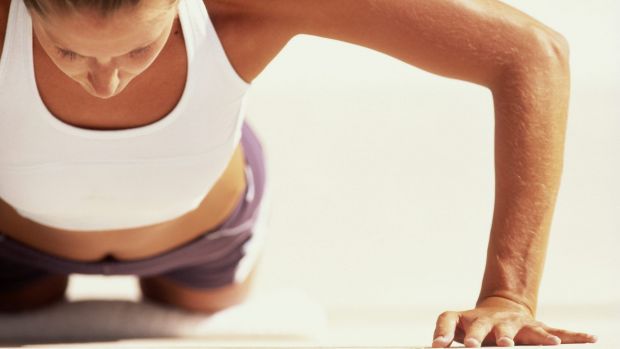
No equipment required: a body weight trend.
Pilates ain’t nothing but a fad, according to the latest American College of Sports Medicine (ACSM) report.
But, the top “new” trend for fitness in 2015 ain’t nothing new either.
In fact, we’ve been doing it for centuries. In the report, based on the responses of more than 3400 health and fitness professionals, body weight training was named the number one fitness trend for the new year.
The Ancient Greeks were into push ups and pull ups, but the term was only defined in the 1890s.
It took until 2013 before body weight training, which also includes star jumps and burpees, was officially recognised as a “trend'[.
“New packaging, particularly by commercial clubs, has now made it popular in all kinds of gyms,” says Walter Thompson, the vice-president of ACSM.
Trailing body weight training were various other forms of mobility and strength training, including high intensity interval training (HIIT) which dropped into second place from last year’s top spot), possibly because the intensity of the training has also led to a large number of injuries among participants.
“HIIT is great for people who have a base and have a reasonable condition,” says Steve “Commando” Willis. “People who are carrying excess weight, can’t handle that stress and they may get results quickly but it comes at a cost.”
Strength training and yoga (there are now about 3000 yoga studios in Australia) were also among the top 10.
Nowhere to be seen though was CrossFit, despite it being among the most Googled fitness terms in Australia.
Pilates was also among our most Googled terms, but it did not make the top 20 either, which supports the theory that these are fads not trends, Thompson says.
Luke Istomin, founder of F45, however was “quite surprised” that Pilates was named a fad.
“I can’t see it disappearing from the Australian market any time soon,” he says, noting its reinvention through power pilates and hip-hop pilates classes as well as the newly popular, pilates-based barre body and air barre classes.
Willis, however, believes the “fad” part of pilates represents a general trend away from fitness regimes that use parts of the body in isolation.
“The one thing I’ve learned about exercise is that you need to connect the dots … you need to work the body as a whole,” the Biggest Loser trainer says. “You need to be able to apply what you’re doing in real life.”
This might explain the popularity of functional fitness, body weight and mobility-based training.
“There is a definite move towards this type of programming because people are realising it’s the most effective style of training for a majority of people, is cheap and versatile, as well as being a lot safer, with more longevity than a lot of the fads,” says Libby Babet of Sydney’s agoga and the women’s online bufgirl.com.
She points out that as well as being effective, such forms of exercise can be carried out anywhere, anytime, don’t require clunky pieces of equipment (if any) and are now accessible to anyone via online programs.
“I’ve seen mobile apps like Zova and Freeletics launch with incredible success and build their customer bases at an astronomical rate,” she says.
“I think online training is on its way but people are still more motivated with human company,” says Aaron Mckenzie of Origin of Energy, noting that many of the more popular group exercise classes – including CrossFit – fall under the umbrellas of the top trends.
“All of these are using High Intensity Interval circuit style training,” he says. “Even yoga is becoming more high intensity acro-based.”
As far as future Australian fitness trends are concerned, Mckenzie sees them being influenced by CrossFit, Paleo-based nutrition, organics and meditation.
“Hopefully the military bootcamp style training is on its way out and is replaced with high quality small group training,” he says, with the other experts all agreeing that boutique, small group training classes are on the rise.
Willis, who has just launched a web-based, bodyweight program called Commando Steve’s “Get Commando Fit” Mission 2, agrees with Babet that online sessions are a growing trend.
Like Mckenzie, he also believes there is a move towards a more balanced, integrated approach to fitness, health, nutrition and wellbeing.
To create his programs he now consults with nutritionists and sports scientists.
“Time is precious to all of us,” he says, adding that offering complete fitness and health programs provides a one-stop shop.
“Addressing nutrition, mental and physical wellbeing – I feel like that’s going to be a strong trend worldwide,” says Istomin.
1. Body weight training
2. High-intensity interval training
3. Educated, certified, and experienced fitness professionals
4. Strength training
5. Personal training
6. Exercise and weight loss
7. Yoga
8. Fitness programs for older adults
9. Functional fitness
10. Group personal training
11. Worksite health promotion
12. Outdoor activities
13. Wellness coaching
14. Circuit training
15. Core training
16. Sport-specific training
17. Children and exercise for the treatment/prevention of obesity
18. Outcome measurements
19. Worker incentive programs
20. Boot camp
